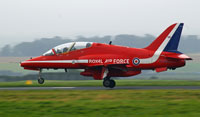|

|
|

|
The Hawk has been widely exported as a trainer and
single-pilot fighter ground attack aircraft – in numerical terms, by
far the most successful British export programme since the Hawker
Hunter.
By 2005, over 800 Hawks had been exported or
ordered, including 189 for the US Navy under licence arrangements, in
addition to the 176 delivered to the RAF.
The Hawk first flew in 1974, and entered RAF
service two years later both as an advanced flying trainer and a
weapons training aircraft. It has an economical Adour engine an
un-reheated version of the same turbofan powering the Jaguar.
Hawks are used to teach operational tactics such as air-to-air and
air-to-ground firing, air combat and low-level operating procedures to
pilots destined for the 'fast-jet' squadrons. As a weapons trainer,
the Hawk is armed with an Aden cannon carried beneath the fuselage,
and rocket pods or practice bombs can be fitted to under-wing pylons.
To fulfil its mobilisation role as a fighter aircraft, the Hawk
carries a 30 mm Aden cannon and two Sidewinder air‑to‑air missiles,
and is designated T1A (89 delivered to the RAF). The Hawk is a strong
and rugged aircraft designed to cut training and maintenance costs.
The aircraft has a long fatigue life to ensure a service career
throughout the 1990s and beyond.
During January 1998, the MoD announced plans to extend the fatigue
life of the Hawk T1/1A in RAF service. Up to 80 Hawks were involved in
a 'return-to-works' (RTW) programme that saw their centre and rear
fuselage sections being replaced with new production units from the
Hawk Series 60 production line. This programme will extend the Hawk's
service life to 2010.
In July 2003 the
Hawk T2 (128) was selected as the new Advanced Jet Trainer (AJT) for
the RAF and Royal Navy fast-jet aircrew training. Aircrew trained on
the Hawk T2 (128) will move onto operational service with Harrier,
Tornado, Typhoon and the future Joint Combat Aircraft.
Hawk T2 (128) will be able to provide pilots in training with the
all-digital, fly-by-wire experience necessary for pilots flying the
latest generation of fast jets.
The initial contract is for 20 x Hawk T2 (128) with an option for a
further 24 aircraft. If all 44 aircraft are purchased the total
contract value will be in the region of £3.5 billion (including 20
years through life support). We would expect an in-service date of
around 2010-2011.
|
BAE HAWK Specifications |
|
Type |
Advanced Trainer and light
attack |
|
Manufacturer |
British
Aerospace |
|
Accommodation |
Two either student and instructor or pilot and
navigator |
|
Armament |
One 30 mm Aden cannon pack and up to 5,600 lb
(2,540 kg) of underwing stores (rockets, bombs and missiles) theT1A - in
addition has inboard pylons for Sidewinder AIM-9 air-to-air missiles. |
|
Performance |
Max Speed 622 mph (1,000 km/h) |
|
Wing Span |
32ft 7in (9.94m) |
|
Length |
40ft 7in (12.43m) |
|
Height |
13ft 1in (3.98m) |
|
Weight |
Empty 9,792lb (4,440kg) Max Take off Weight
20,069lb (9,100kg) |
|
Powerplant |
Rolls-Royce/Turbomeca
Adour Mk.951 turbofan engine with 6,500 lb of thrust |
|
Variants |
T1 and T1A |
Photo Copyright
Alasdair Taylor
|